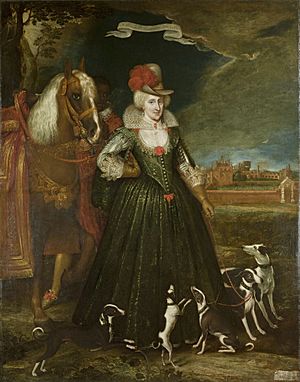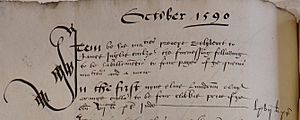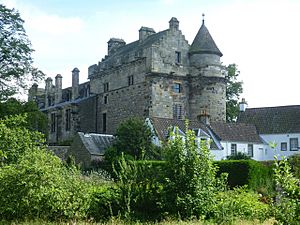Anne of Denmark and her African servants facts for kids

Anne of Denmark (1574–1619) was a queen. She was married to James VI and I, who was King of Scotland and later King of England. A painting from 1617 by Paul van Somer shows Queen Anne with an African servant. This servant is holding her horse. Historical records show that African people, sometimes called "Moors," worked for Queen Anne.
Contents
Royal Journeys and Entertainments
In October 1589, King James VI sailed to Norway to meet Anne of Denmark. One story says they saw African men dancing in the snow in Oslo. Some dancers sadly died from the cold. The dancers who survived continued with the royal group to Denmark and then to Scotland. We know the royal couple enjoyed performances by acrobats in Oslo and Denmark.
Anne of Denmark in Scotland
A Grand Welcome in Edinburgh
Queen Anne and King James arrived in Scotland in May 1590. A few months later, a list of her household members included an African servant. It is not clear if he had already been with her in Denmark.
Soon after their arrival, a big parade was held in Edinburgh on May 19. This parade celebrated Queen Anne's entry into the city. A person watching from Denmark wrote about the parade. He said there was "an absolutely real and native blackamoor" leading the way for the royal group. This man carried a sword. Other performers were men from Edinburgh who had blackened their faces or wore black masks. They danced before the queen.
A poet named John Burel wrote that these performers were like "Moirs" from far-off lands. They had come to greet Scotland's new queen. They marched in front of her down the Canongate street to her palace, Holyroodhouse.
It is not known if the man in the parade was the same African servant later listed in Queen Anne's household. This servant, like other staff, received food and drink. He wore special clothes made of orange velvet and Spanish taffeta. This outfit was similar to those worn by other young men who served the queen.
Clothes for Royal Servants

Tailors made clothes for the queen's servants in late 1590. The African servant received an orange velvet jacket and breeches. He also had a doublet (a type of close-fitting jacket) made of shiny Spanish taffeta. His hat was yellow. The queen's four pages wore cloaks of orange cloth. The velvet for the African servant's clothes came from the queen's own supply.
Records of payments to this African servant are not found after this time. However, this does not mean he was not paid. Some royal servants worked for years without clear payment records.
A Burial at Kilgour


An African servant at the Scottish court was buried near Falkland in July 1591. King James VI paid for the funeral costs. It is not clear if this was the same person from the 1590 parade or the one who received clothes. The church and burial ground at that time were at Kilgour, west of Falkland Palace.
African Servants in England
African servants also worked at the English court. Elizabeth I had a young African page in 1574 and 1575. He was called "a littell Black a More" in records. He wore fancy clothes with gold and silver. He likely attended the queen in her royal rooms. His presence showed the queen's power.
A Special Performance at Stirling Castle

In August 1594, Queen Anne's son, Prince Henry, was baptized at Stirling Castle. At the celebration feast, an African man performed. He pulled a special cart with six ladies holding desserts towards the main table. He pretended to pull the cart with chains that looked like gold. Hidden workers actually pushed the cart.
This performance was a last-minute change. Originally, a lion was supposed to pull the cart. But they worried a lion might scare the guests. So, the African actor took its place. This actor might have been the same person from the Edinburgh parade in 1590. The women on the cart represented goddesses like Ceres (of farming) and virtues like Faith and Generosity. They celebrated Queen Anne and offered good things to Scotland. This show was written by William Fowler.
Anne of Denmark in England
The man in Paul van Somer's 1617 painting of Anne of Denmark might have been a member of her household in England. He could have been a page or a groom (someone who looks after horses). His red and gold clothes might be the royal colors of Denmark. His name is not known. Records of the royal stable show names of grooms who worked for Queen Anne.
The painting shows the queen with her dogs in the park at Oatlands Palace. Queen Anne owned Italian greyhounds. The gate in the background was designed by Inigo Jones, who also designed costumes for her plays. The painting may have been made to show Queen Anne's importance as queen. The African groom in the picture might have been included to make the queen look even more powerful. He looks at her with respect, inviting the viewer to do the same.
Culture and Theatre
A pair of earrings made for Queen Anne by George Heriot still exist today. They have small faces of African men on them. These earrings might show her interest in how African people were shown in plays.
For example, in 1605, Queen Anne performed in a play called Masque of Blackness. She and eleven ladies appeared with blackened faces. They played the daughters of "Father Niger," a character representing the River Niger. The story was that these daughters would turn white in Britain. This play was written by Ben Jonson. Queen Anne's choice to perform in this play was her own idea.
Some historians believe that Queen Anne's choice to appear in blackface was a way for her to show her independence. It also connected to the growing contact between Europeans and people from Africa and other parts of the world.

